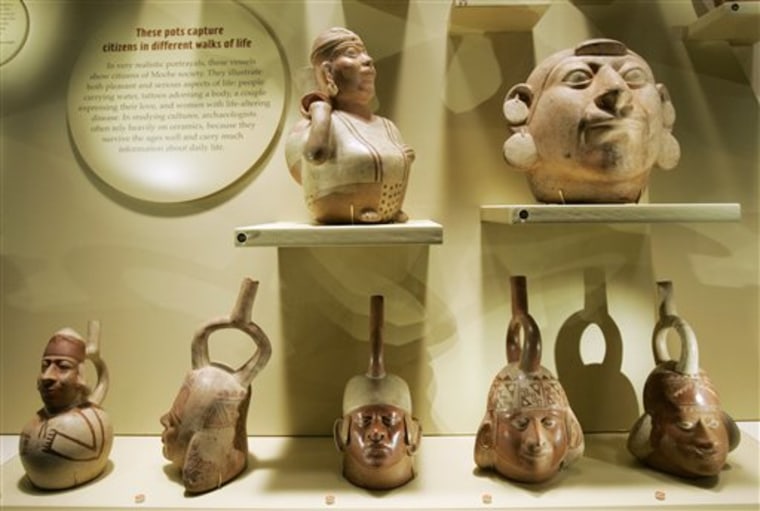Aztec. Incan. Mayan.
They're the most widely recognized ancient cultures of North, South and Central America, according to visitors surveyed by The Field Museum.
But a new exhibit called "The Ancient Americas" shows that the Western Hemisphere was home to hundreds of diverse societies established long before European explorers arrived in the late 15th and early 16th centuries.
The hunter-gatherers of the Clovis society of North America perfected a spear 13,000 years ago that could pierce the skin of a mammoth. The Tairona culture of present-day Colombia crafted elaborate gold jewelry 1,500 years ago. And in 500 A.D., more people lived in the city of Teotihuacan in central Mexico than in Rome.
The permanent exhibit, which opened last week, encompassed five years of work, including the public surveys that helped guide its developers. It represents a major overhaul of the museum's old exhibit, which dated to the 1950s and focused on the archaeology of the Americas.
Not only was some of the information incorrect or outdated, according to museum staff, it also was not engaging enough to compete with television, the Internet and travel — all options for learning about other cultures in the 21st century.
"It used to be case after case after case of objects, sitting there with label after label after label," said David Foster, the Field's project management director. "Very little means for the visitor to understand these societies in all their dimensions — to understand what an artifact signified, or why it was made, or who used it, or what they used it for."
"The Ancient Americas" takes a very different approach.
Exhibits no longer are grouped in chronological order, but around the strategies early ancient Americans developed to meet their unique challenges.
For example, one section is devoted to cultures — such as the Pueblo people of the North American Southwest — that settled in villages to raise crops and livestock. Another section addresses cultures governed by powerful rulers, such as the Zapotec of Oaxaca, Mexico, who controlled the military, economic and religious aspects of their societies.
Visitors can watch videos of archaeologists working in the field, push a button and hear the Mayan language, or trace a path through a glass model of a massive city laid out in a grid pattern, much like Chicago is. Through text, they also learn that bloodletting and human sacrifice was a feature of some of the culture's religions.
The exhibit seeks to move away from the idea that cultural evolution is necessarily a sign of progress.
Visitors learn, for example, that hunter-gatherers had a lot of leisure time because they only had to work two to three hours a day to collect their food.
Some egalitarian farming societies lasted for centuries, compared to approximately 150 years for the Incan and Aztec empires, in which far-flung communities were required to pay taxes and tribute to their leaders.
The exhibit's lead curator, Jonathan Haas, said he hopes the exhibit helps visitors appreciate the accomplishments of the people and cultures of North, South and Central America.
"They are woefully underrepresented and misunderstood in the public's eyes, and we have a responsibility to change that," he said.
Besides the interactive and technological elements, the exhibit features 2,200 artifacts, representing more than 20 distinct societies, all drawn from the Field's extensive collection.
Among the highlights:
- More than 100 pieces of ceramic pottery from the Moche culture, which lived along the northern coast of Peru. The unique, quirky vessels depict individual people from different backgrounds — instead of the generic, idealized faces common in artwork of many other societies. On one vessel, a woman bends under the weight of the water jug on her back; on another, a man and woman embrace.
- A black-and-white checkered cotton shirt likely worn by a high-ranking Incan official.
- Wooden cradle boards, used by women to carry their babies while working in fields, and a baby's sandal that have survived for more than 1,000 years.
- A tiny green stone figurine of a leader wearing an elaborate headdress of animal skins, made by the Wari people of south Peru.
- Massive, wide-mouthed vessels used to store a type of beer made of fermented maize served by Tairona leaders at huge feasts.
Near the end of the exhibit, a small room containing a broken sculpture touches on the first contact of indigenous Americans with European explorers.
The museum estimates that within the first several centuries of the Europeans' arrival, 90 percent of an overall indigenous population that once numbered in the millions were dead, mostly from diseases such as smallpox.
But instead of ending on that sad note, the exhibit closes with a large room where visitors can watch videos of indigenous artists keeping cultural traditions alive. Performances are planned for the space, as well.
And throughout the exhibit are portraits of descendants of indigenous people — such as Evo Morales, the president of Bolivia, and Wilma Mankiller, the first female chief of the Cherokee Nation.
"We use this exhibit to tell the story of humanity — all humanity," Haas said.
